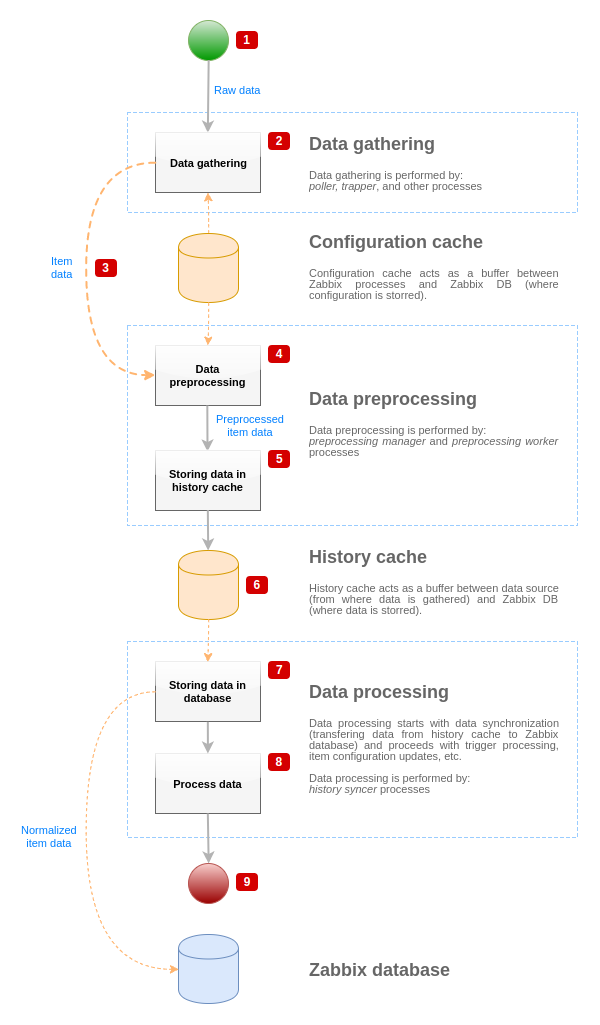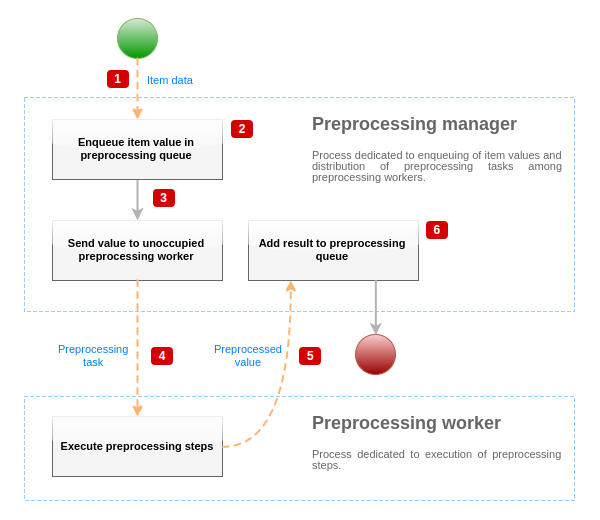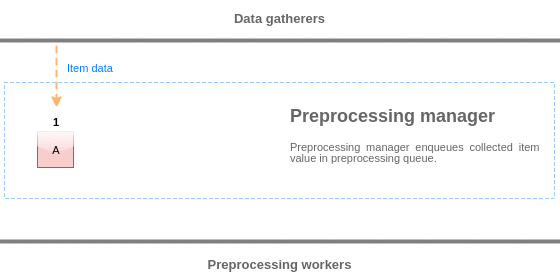Is this not what you were looking for? Switch to the current version or choose one from the drop-down menu.
1 Preprocessing details
Overview
This section provides item value preprocessing details. Item value preprocessing allows to define and execute transformation rules for the received item values.
To learn about configuring basic preprocessing steps, see: Item value preprocessing.
Preprocessing is managed by a preprocessing manager process, which was added in Zabbix 3.4, along with preprocessing workers that perform the preprocessing steps. All values (with or without preprocessing) from different data gatherers pass through the preprocessing manager before being added to the history cache. Socket-based IPC communication is used between data gatherers (pollers, trappers, etc) and the preprocessing process. Either Zabbix server or Zabbix proxy (for items monitored by the proxy) is performing preprocessing steps.
Item value processing
To visualize the data flow from data source to the Zabbix database, we can use the following simplified diagram:

The diagram above shows only processes, objects and actions related to item value processing in a simplified form. The diagram does not show conditional direction changes, error handling or loops. Local data cache of preprocessing manager is not shown either because it doesn't affect data flow directly. The aim of this diagram is to show processes involved in item value processing and the way they interact.
- Data gathering starts with raw data from a data source. At this point, data contains only ID, timestamp and value (can be multiple values as well)
- No matter what type of data gatherer is used, the idea is the same for active or passive checks, for trapper items and etc, as it only changes the data format and the communication starter (either data gatherer is waiting for a connection and data, or data gatherer initiates the communication and requests the data). Raw data is validated, item configuration is retrieved from configuration cache (data is enriched with the configuration data).
- Socket-based IPC mechanism is used to pass data from data gatherers to preprocessing manager. At this point data gatherer continue to gather data without waiting for the response from preprocessing manager.
- Data preprocessing is performed. This includes execution of preprocessing steps and dependent item processing.
Item can change its state to NOT SUPPORTED while preprocessing is performed if any of preprocessing steps fail.
- History data from local data cache of preprocessing manager is being flushed into history cache.
- At this point data flow stops until the next synchronization of history cache (when history syncer process performs data synchronization).
- Synchronization process starts with data normalization storing data in Zabbix database. Data normalization performs conversions to desired item type (type defined in item configuration), including truncation of textual data based on predefined sizes allowed for those types (HISTORY_STR_VALUE_LEN for string, HISTORY_TEXT_VALUE_LEN for text and HISTORY_LOG_VALUE_LEN for log values). Data is being sent to Zabbix database after normalization is done.
Item can change its state to NOT SUPPORTED if data normalization fails (for example, when textual value cannot be converted to number).
- Gathered data is being processed - triggers are checked, item configuration is updated if item becomes NOT SUPPORTED, etc.
- This is considered the end of data flow from the point of view of item value processing.
Item value preprocessing
To visualize the data preprocessing process, we can use the following simplified diagram:

The diagram above shows only processes, objects and main actions related to item value preprocessing in a simplified form. The diagram does not show conditional direction changes, error handling or loops. Only one preprocessing worker is shown on this diagram (multiple preprocessing workers can be used in real-life scenarios), only one item value is being processed and we assume that this item requires to execute at least one preprocessing step. The aim of this diagram is to show the idea behind item value preprocessing pipeline.
- Item data and item value is passed to preprocessing manager using socket-based IPC mechanism.
- Item is placed in the preprocessing queue.
Item can be placed at the end or at the beginning of the preprocessing queue. Zabbix internal items are always placed at the beginning of preprocessing queue, while other item types are enqueued at the end.
- At this point data flow stops until there is at least one unoccupied (that is not executing any tasks) preprocessing worker.
- When preprocessing worker is available, preprocessing task is being sent to it.
- After preprocessing is done (both failed and successful execution of preprocessing steps), preprocessed value is being passed back to preprocessing manager.
- Preprocessing manager converts result to desired format (defined by item value type) and places result in preprocessing queue. If there are dependent items for current item, then dependent items are added to preprocessing queue as well. Dependent items are enqueued in preprocessing queue right after the master item, but only for master items with value set and not in NOT SUPPORTED state.
Value processing pipeline
Item value processing is executed in multiple steps (or phases) by multiple processes. This can cause:
- Dependent item can receive values, while THE master value cannot. This can be achieved by using the following use case:
* Master item has value type ''UINT'', (trapper item can be used), dependent item has value type ''TEXT''.
* No preprocessing steps are required for both master and dependent items.
* Textual value (like, "abc") should be passed to master item.
* As there are no preprocessing steps to execute, preprocessing manager checks if master item is not in NOT SUPPORTED state and if value is set (both are true) and enqueues dependent item with the same value as master item (as there are no preprocessing steps).
* When both master and dependent items reach history synchronization phase, master item becomes NOT SUPPORTED, because of the value conversion error (textual data cannot be converted to unsigned integer).As a result, dependent item receives a value, while master item changes its state to NOT SUPPORTED.
- Dependent item receives value that is not present in master item history. The use case is very similar to the previous one, except for the master item type. For example, if
CHARtype is used for master item, then master item value will be truncated at the history synchronization phase, while dependent items will receive their value from the initial (not truncated) value of master item.
Preprocessing queue
Preprocessing queue is a FIFO data structure that stores values preserving the order in which values are revieved by preprocessing manager. There are multiple exceptions to FIFO logic:
- Internal items are enqueued at the beginning of the queue
- Dependent items are always enqueued after the master item
To visualize the logic of preprocessing queue, we can use the following diagram:

Values from the preprocessing queue are flushed from the beginning of the queue to the first unprocessed value. So, for example, preprocessing manager will flush values 1, 2 and 3, but will not flush value 5 as value 4 is not processed yet:

Only two values will be left in queue (4 and 5) after flushing, values are added into local data cache of preprocessing manager and then values are transferred from local cache into history cache. Preprocessing manager can flush values from local data cache in single item mode or in bulk mode (used for dependent items and values received in bulk).
Preprocessing workers
Zabbix server configuration file allows users to set count of preprocessing worker processes. StartPreprocessors configuration parameter should be used to set number of pre-forked instances of preprocessing workers. Optimal number of preprocessing workers can be determined by many factors, including the count of "preprocessable" items (items that require to execute any preprocessing steps), count of data gathering processes, average step count for item preprocessing, etc.
But assuming that there is no heavy preprocessing operations like parsing of large XML / JSON chunks, number of preprocessing workers can match total number of data gatherers. This way, there will mostly (except for the cases when data from gatherer comes in bulk) be at least one unoccupied preprocessing worker for collected data.
Too many data gathering processes (pollers, unreachable pollers, HTTP pollers, Java pollers, pingers, trappers, proxypollers) together with IPMI manager, SNMP trapper and preprocessing workers can exhaust the per-process file descriptor limit for the preprocessing manager. This will cause Zabbix server to stop (usually shortly after the start, but sometimes it can take more time). The configuration file should be revised or the limit should be raised to avoid this situation.

